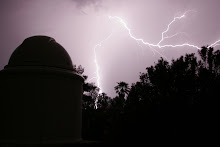
Observed along with 11 Parthenope. This is an unusual event as these two asteroids are going to pass extremely close to each other from our perspective (they actually will be rather distant from each other in reality, but their apparent position in the sky as viewed from Earth will be quite close).
This picture is a single 1.1 second exposure in the CCD, no processing other than adding the identification arrows and conversion to jpeg format.
I shot 50 of these images but unfortunately that probably won't be enough to detect motion since the asteroids are only moving 0.0016 and 0.0023 arcseconds per second and the CCD scale at 2x2 binning is only 1.1 arcseconds, and seeing was not perfect of course. However I will still stack them to see, and hopefully I will get some more photos over the next few nights. No more possible tonight as the dome wall is starting to get in the way.
There's a Japanese spacecraft called Hayabusa on its way back from a asteroid Itokawa right now - pretty amazing that we know of so many asteroids given that the first one, Ceres, was discovered in 1801, only about 200 years ago!
BTW I must give credit to Astronomy Magazine and my good friend Alfredo for alerting me to this special asteroid event.

No comments:
Post a Comment